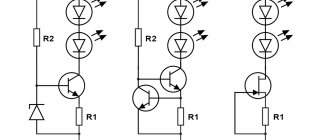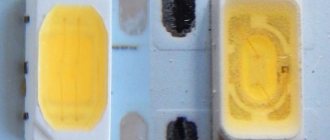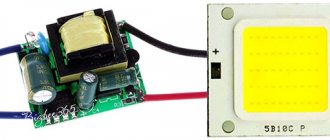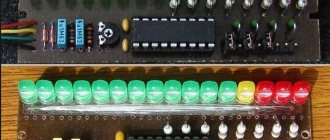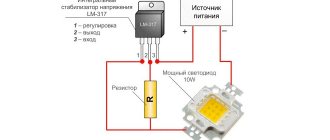Long gone are the days when LEDs were used exclusively as indicator lights. Today it is a worthy alternative to incandescent lamps that are common in everyday life and in industrial settings. Thanks to the expanding range of applications of LED devices, limitless scope is opening up in the field of filling streets and rooms with artificial light. Today we'll talk about this on.
What is LED?
LEDs form an integral part in modern electronics, simple indicators for optical communication devices.
Light-emitting diodes use the properties of a pn junction and emit photons when current flows in the forward direction. LEDs specifically emit light when potentials are applied to the anode and cathode. The history of LEDs dates back to 1907, when Captain Henry Joseph observed the electro-luminescence characteristics of silicon carbide. The first LED was developed in 1962. It was developed by Holonyak, who worked for General Electric (GE). It was a GaAsP device. The first commercial version of LEDs came to market in the 1960s.
The manufacturing of LED technology boomed in the 1970s with the introduction of gallium aluminum arsenide (GaAlAs). These LEDs are high brightness and many times brighter than the old diffuse type. Blue and white LEDs were introduced in 1990, which use indium gallium nitride (InGaN) as a semiconductor. The white LED contains inorganic phosphorus. When the blue light inside the LED hits the phosphor, it emits white light.
Advantages and disadvantages
More and more users are seeking to replace outdated incandescent lamps with modern models of LED lamps. The main advantages of using LEDs:
- saving energy without compromising the luminous flux of the lamp;
- durable materials of the body and internal elements: low probability of mechanical damage;
- long service life: several times higher than that of Ilyich bulbs;
- size: diodes are compact and quite mobile;
- high brightness;
- safety: minimum network voltage – 3-24V.
Disadvantages include high cost and the need for constant voltage. The price of products is gradually decreasing due to high consumer demand.
What makes an ideal LED?
LEDs are widely used in electronic circuits due to its advantages over lamps. Some important features are:
- The LEDs are encased in plastic so they can withstand mechanical shock.
- Unlike lamps, LEDs do not emit heat and there is virtually no power loss when heated.
- LEDs require very low current and voltages are typically 20 mA at 1.8 volts. So this is ideal in battery circuits.
How to determine current
Finding out what rated current an LED has without using special reference books is not so easy. By appearance, the current strength can be determined by the diode bulb: the larger it is, the greater the current. If during the test you cross the acceptable line, the color of the diode will change. For example, an initially yellow color may turn into a white or blue tint.
Most standard LEDs are rated at 20mA.
Modern technologies make it possible to supplement the device body with new components. The most commonly used are quenching resistors. In this way you can get an LED with a voltage of 5.12 or 220 V.
In addition, the rated current of the LED is determined by the same multimeter. When the light comes on, pay attention to the device screen; the voltage will be displayed on it; knowing it and Ohm’s law, you can easily calculate the LED current.
After watching the video, you can understand how to test different types of LEDs using a multimeter.
LED technology
Brightness is an important aspect of LED. The human eye has a maximum sensitivity to light of about 550 nm in the yellow-green part of the visible spectrum. This is why the green LED emits brighter than the red LED even though both use the same current. Important parameters of LEDs are:
- Luminous Flux Indicates the energy of light coming from the LEDs. It is measured in Lumen (lm) or Milli Lumen (MLM)
- The luminous intensity of a luminous flux covering a large area is luminous intensity. It is defined as Candela (cd) or milli candela (MCD). The brightness of an LED is directly related to its luminous intensity.
- Luminous efficiency This is the relative light energy emitted to the power consumed. It is measured in terms of lumens per watt (lm W).
Forward current, forward voltage, viewing angle and response speed are factors that affect the brightness and efficiency of LEDs. Forward current (I) is the current flowing through an LED when it is forward biased and it should be limited to 10 to 30 milliamps, anything higher will destroy the LEDs.
The viewing angle is from - the axis angle at which the light intensity falls to half the axial value. This is why the indicator shows more brightness in the full state. Tall, bright LEDs have a narrow viewing angle so that the light is focused into a beam. Operating voltage (V) is the voltage drop across the LED. The voltage drop ranges from 1.8 V to 2.6 volts for regular LEDs, but in blue and white it will go up to 5 volts. Response speed represents how quickly the LED turns on and off. This is a very important factor if LEDs are used in communication systems.
Is a ballast resistor required?
LEDs are always connected to a power source via a resistor. This resistor is called a "ballast resistor", which protects the diode from damage caused by excess current. It regulates the forward current to the LED to a safe limit and protects it from burning.
The resistor value determines the forward current and, therefore, the brightness of the LEDs. Vs - Vf equation is used to select a resistor. Vs represents the input voltage of the circuit, Vf is the forward voltage drop of the LED(s) at the permissible current through the LED. The resulting value will be in Ohms. It is better to limit the current to a safe limit of 20 mA.
The table below shows the forward voltage drop across the LED.
| Red | Orange | Yellow | Green | Blue | White |
| 1.8 V | 2 V | 2.1 V | 2.2 V | 3.6 V | 3.6 V |
A typical LED can carry 30 -40 mA of safe current through it . The current rating to give sufficient brightness, a standard red LED is 20 mA. But it could be 40mA for blue and white LED. Current limiting by a ballast resistor protects the diode from excess current flowing through it. The ballast resistor value must be carefully selected to prevent damage to the LEDs and also to obtain sufficient brightness at 20 mA current. The following equation explains how to select a ballast resistor.
R=V/I
Where R is the resistance value in ohms, V is the input voltage to the circuit, and I is the permissible current through the LED in amperes. For a typical red LED, the forward voltage drop is 1.8 volts. So if the supply voltage is 12V (Vs), the voltage drop across the LED is 1.8V (V) and the allowable current is 20mA (IF), then the value of the ballast resistor will be
Vs - Vf / If = 12 - 1.8 / 20 mA = 10.2 / 0.02 = 510 Ohm.
But if a 510 Ohm resistor is not available, then you can choose the closest one, for example a 470 Ohm resistor can be used even if the current through the LED increases slightly. But it is recommended to use a 1K resistor to increase the life of the LEDs, although there will be a slight decrease in brightness.
Below is the arithmetic for choosing a limiting resistor for different versions of LEDs at different voltages.
| Voltage | Red | Orange | Yellow | Green | Blue | White |
| 12 V | 470 Ω | 470 Ω | 470 Ω | 470 Ω | 390 Ω | 390 Ω |
| 9V | 330 Ω | 330 Ω | 330 Ω | 330 Ω | 270 Ω | 270 Ω |
| 6 V | 180 Ω | 180 Ω | 180 Ω | 180 Ω | 120 Ω | 120 Ω |
| 5 V | 180 Ω | 150 Ω | 150 Ω | 150 Ω | 68 Ω | 68 Ω |
| 3V | 56 Ω | 47 Ω | 47 Ω | 33 Ω | — | — |
With the addition of other colors
An LED that can produce different colors is useful in some applications. For example, LEDs can indicate all systems are OK when it turns green, and faulty when it turns red. LEDs that can produce two colors are called Bicolour LEDs.
Bi-color LED covers two LEDs (usually red and green) in an overall package. Two crystals are installed on two terminals. A bi-color LED produces red when current flows in one direction and turns green when the direction of current is reversed.
Tricolor and multicolor LEDs are also available, which have two or more chips housed in a common housing. A tri-color LED has two anodes for a red and green crystal and a common cathode. Thus, it emits red and green colors depending on the anode in which the current is present. If both anodes are connected, the LEDs emit light and the color is yellow. A common anode and separate cathode type LEDs are also available.
The two-color indicator lights up in different colors ranging from green through yellow, orange and red to base on the current flowing through their anodes by selecting a suitable resistor to limit the anode current. Multicolor LEDs contain more than two chips—usually red, green, and blue chips—in a single package. Flashing LEDs in different colors, now available with two outputs. This gives a rainbow of colors that are quite attractive.
How to find out how many volts it is rated for
Using a power supply
One quick way to determine LED voltage is to use a regulated power supply. The power supply must be regulated from scratch and at the same time make it possible to control the current, or even better, limit it.
To measure, follow these steps:
- Connect the LED to the source, observing the polarity.
- Gradually increase the voltage to 3-3.5V.
At a certain moment, the diode will light up at full strength - this means that the voltage level corresponds to the operating current (it can be read using an ammeter). If the device does not have a built-in ammeter, the current must be monitored using an external device.
When the voltage rises, you cannot cross the 3.5 V line. If the LED does not light up at these levels, check the polarity of the device connection.
By appearance
The approximate strength of the operating voltage can be assessed by the appearance, markings and color of the LED. To determine by color spectrum, use the table that was written about earlier in the article.
There is no standard labeling; each manufacturer indicates its own parameters on it. Marking is usually indicated on packaging containers (boxes and bags). If you purchase LEDs that are wound into a reel, ask the seller for the packaging container to find out the LED markings.
Multimeter
To measure the operating voltage of an LED with a multimeter, follow these steps:
- Turn on the multimeter and set the rotary switch to the “diode test” position.
- The LED has two terminals and polarity: short (negative terminal), long (positive terminal). Connect the positive (red) probe of the multimeter to the positive terminal of the LED, and attach the negative (black) probe to the negative terminal.
- If the LED is working properly, the light will light up.
Infrared diode - source of Invisible light
IR diodes are widely used in remote control (remote control). Infrared diodes actually emit normal light with a specific color that is not sensitive to the human eye because its wavelength is 950 nm, below the visible spectrum. Many sources such as the sun, lamps, even the human body emit infrared rays. It is therefore necessary to modulate the emission from an IR diode to use it in an electronic application to prevent false triggering. Modulation makes the signal from the IR LED significantly higher than the noise. Infrared diodes are found in housings that are opaque to visible light, but transparent to infrared. IR LEDs are widely used in control systems.
Infrared diodes
Photodiode - It can see light
A photodiode generates current when its pn junction receives photons from visible or infrared light. The primary operation of a photodiode depends on the absorption of photons in the semiconductor material. The photo-generated carriers are separated by an electric field, and the resulting photocurrent is proportional to the incident light. The speed at which carriers move in the depletion region is related to the strength of the electric field throughout the region and the mobility of the carriers.
A photon that is absorbed by a semiconductor in the depletion region will lead to the formation of electron-hole conduction. Holes and electrons will be transported by the electric field to the edges of the depletion region. After the carriers leave the depletion region, they go to the photodiode terminals to generate photo-current in the external circuit. Photodiode response time is typically 250 nanoseconds.
Photodiodes
Main conclusions
The ability to determine the operating characteristics of an LED allows you to create an optimal operating mode for it. As a result, the element will be able to demonstrate maximum service life and efficiency, and produce sufficient brightness without overload. Knowing the nominal parameters of the device will allow you to correct connection errors, select the most suitable type of power source, and avoid emergency situations or overloads. The ability to correctly determine the characteristics of an LED implies knowledge of various testing methods, from a simple determination of performance, to a more detailed check of operating current, voltage and power. This will expand the possibilities and allow you to use one of the options available in the given conditions.
Laser diodes
A laser diode is similar to a regular clear LED, but produces laserwith high intensity. In a laser beam, a number of atoms vibrate in such a cycle that all emitted radiation of the same wavelength is in phase with each other. Laser light is monochromatic and travels in the form of a narrow beam. The beam of a typical laser diode is 4 mm x 0.6 mm, which only expands to 120 mm at a distance of 15 meters.
The laser diode can be turned on and off at higher frequencies even higher than 1 GHz. So it is quite useful in telecommunication systems. Since laser generates heat to damage body tissues, it is used in surgery to heal lesions in very sensitive parts like retina, brain, etc. Laser diodes are important components in CD players to obtain the data recorded in CDs.


